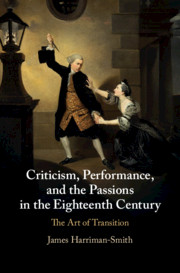18 results
Chapter 5 - Performing Restoration Shakespeare in the Eighteenth Century
-
-
- Book:
- Performing Restoration Shakespeare
- Published online:
- 28 January 2023
- Print publication:
- 26 January 2023, pp 97-117
-
- Chapter
- Export citation
Index
-
- Book:
- Criticism, Performance, and the Passions in the Eighteenth Century
- Published online:
- 02 March 2021
- Print publication:
- 18 March 2021, pp 228-236
-
- Chapter
- Export citation
Coda
-
- Book:
- Criticism, Performance, and the Passions in the Eighteenth Century
- Published online:
- 02 March 2021
- Print publication:
- 18 March 2021, pp 184-189
-
- Chapter
- Export citation
Copyright page
-
- Book:
- Criticism, Performance, and the Passions in the Eighteenth Century
- Published online:
- 02 March 2021
- Print publication:
- 18 March 2021, pp iv-iv
-
- Chapter
- Export citation
Chapter 1 - Dramatic Transition
-
- Book:
- Criticism, Performance, and the Passions in the Eighteenth Century
- Published online:
- 02 March 2021
- Print publication:
- 18 March 2021, pp 22-54
-
- Chapter
- Export citation
Chapter 4 - King Lear
-
- Book:
- Criticism, Performance, and the Passions in the Eighteenth Century
- Published online:
- 02 March 2021
- Print publication:
- 18 March 2021, pp 116-152
-
- Chapter
- Export citation
Chapter 5 - Dramatic Character
-
- Book:
- Criticism, Performance, and the Passions in the Eighteenth Century
- Published online:
- 02 March 2021
- Print publication:
- 18 March 2021, pp 153-183
-
- Chapter
- Export citation
Dedication
-
- Book:
- Criticism, Performance, and the Passions in the Eighteenth Century
- Published online:
- 02 March 2021
- Print publication:
- 18 March 2021, pp v-vi
-
- Chapter
- Export citation
Bibliography
-
- Book:
- Criticism, Performance, and the Passions in the Eighteenth Century
- Published online:
- 02 March 2021
- Print publication:
- 18 March 2021, pp 215-227
-
- Chapter
- Export citation
Note on Style
-
- Book:
- Criticism, Performance, and the Passions in the Eighteenth Century
- Published online:
- 02 March 2021
- Print publication:
- 18 March 2021, pp xi-xii
-
- Chapter
- Export citation
Illustrations
-
- Book:
- Criticism, Performance, and the Passions in the Eighteenth Century
- Published online:
- 02 March 2021
- Print publication:
- 18 March 2021, pp viii-viii
-
- Chapter
- Export citation
Chapter 3 - Odes
-
- Book:
- Criticism, Performance, and the Passions in the Eighteenth Century
- Published online:
- 02 March 2021
- Print publication:
- 18 March 2021, pp 83-115
-
- Chapter
- Export citation
Acknowledgements
-
- Book:
- Criticism, Performance, and the Passions in the Eighteenth Century
- Published online:
- 02 March 2021
- Print publication:
- 18 March 2021, pp ix-x
-
- Chapter
- Export citation
Introduction
-
- Book:
- Criticism, Performance, and the Passions in the Eighteenth Century
- Published online:
- 02 March 2021
- Print publication:
- 18 March 2021, pp 1-21
-
- Chapter
- Export citation
Contents
-
- Book:
- Criticism, Performance, and the Passions in the Eighteenth Century
- Published online:
- 02 March 2021
- Print publication:
- 18 March 2021, pp vii-vii
-
- Chapter
- Export citation
Notes
-
- Book:
- Criticism, Performance, and the Passions in the Eighteenth Century
- Published online:
- 02 March 2021
- Print publication:
- 18 March 2021, pp 190-214
-
- Chapter
- Export citation
Chapter 2 - Zara
-
- Book:
- Criticism, Performance, and the Passions in the Eighteenth Century
- Published online:
- 02 March 2021
- Print publication:
- 18 March 2021, pp 55-82
-
- Chapter
- Export citation

Criticism, Performance, and the Passions in the Eighteenth Century
- The Art of Transition
-
- Published online:
- 02 March 2021
- Print publication:
- 18 March 2021

